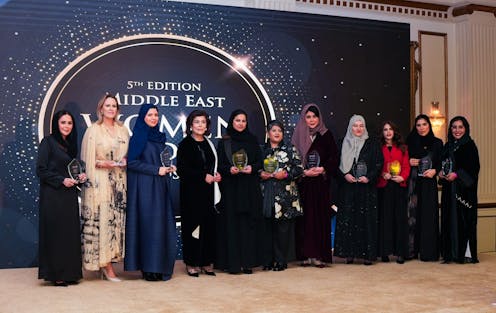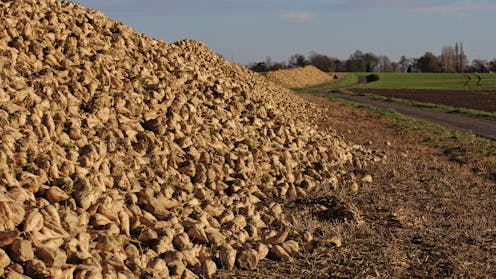Source: The Conversation – France in French (3) – By Eliane Bacha, Professeur-Chercheur en Management, SKEMA Business School

Une évolution des mentalités s’observe dans la plupart des pays du Moyen-Orient en ce qui concerne la possibilité laissée aux femmes d’étudier et d’accéder au marché du travail puis aux postes de direction. Il reste cependant beaucoup à faire ; la mise en place et la généralisation de certaines mesures, telles que le mentorat ou la formation professionnelle, pourraient accélérer le processus.
L’Objectif de développement durable n°5 des Nations unies, adopté en 2015, fixe une ambition claire : « Parvenir à l’égalité des sexes et autonomiser toutes les femmes et les filles ». Cette ambition concerne notamment le monde du travail. En 2025, la proportion de femmes occupant des postes de PDG dans le monde est estimée entre 5 et 6 %. Certains pays se distinguent, comme la Thaïlande et la Chine, où cette proportion est respectivement de 30 % et 19 %.
En 2024, 33,5 % des postes de direction y compris ceux des conseils d’administration dans le monde étaient occupés par des femmes. Ce pourcentage, relativement stable d’une région à l’autre, est surtout porté par une dynamique nouvelle : la montée du nombre de femmes PDG. À titre d’exemples, en Europe de l’Est et en Asie centrale, les femmes occupent environ 20 % des sièges dans les conseils d’administration et 7 % des postes de PDG dans les sociétés cotées en bourse et en Amérique latine, 9 % des PDG sont des femmes et 16 % occupent des sièges dans les conseils d’administration. Une progression qui traduit un changement structurel et qui se manifeste désormais aussi au Moyen-Orient.
L’émergence des femmes leaders au Moyen-Orient
La liste des 100 femmes d’affaires les plus influentes de la région pour l’année 2024 publiée par Forbes Middle East comprend 100 profils, de 28 nationalités (y compris occidentales) qui occupent des postes importants dans des entreprises dans 32 secteurs différents.
Tout en haut du classement figure l’Émiratie Hana Al Rostamani, PDG de First Abu Dhabi Bank, qui conserve cette place de numéro un pour la troisième année consécutive. Diplômée de l’université George Washington aux États-Unis, elle est titulaire d’une licence en administration des affaires et d’un master en gestion de l’information. Avec deux décennies d’expérience dans la banque et les services financiers, elle incarne parfaitement ce que révèle ce classement : les femmes leaders sont de plus en plus visibles et occupent des postes de plus en plus stratégiques.
Cette évolution traduit une modification des mentalités et met en lumière une évidence : les femmes disposent des compétences nécessaires pour accéder à des rôles de premier plan. Une étude menée en 2024 sur le leadership éducatif féminin dans le monde arabe montre que ces dirigeantes se distinguent par leur « agentivité » – c’est-à-dire leur capacité à prendre en main leur destin et leur environnement –, leur autodétermination et leur persévérance.
Une autre étude, publiée en 2017 et consacrée spécifiquement au cas des Émirats arabes unis, souligne que les Émiraties adoptent un style de leadership transformationnel : elles stimulent la créativité de leurs équipes, communiquent leur vision, motivent et soutiennent leurs collaborateurs, et se posent elles-mêmes en modèles.
Mesures visant à soutenir l’avancement des femmes dans la hiérarchie
Ces avancées ne doivent pas masquer la réalité des chiffres. En 2022, les femmes ne représentaient que 19 % de la population active au Moyen-Orient, selon la Banque mondiale. Leur progression professionnelle se heurte à des obstacles bien connus : barrières socioculturelles, idéologies masculines dominantes, croyance répandue selon laquelle leur rôle devrait se limiter à la sphère domestique.
Une étude publiée en 2020, consacrée aux défis rencontrés par les femmes managers dans la région, met en évidence plusieurs freins : la domination des idées masculines dans les sociétés et les organisations, l’absence d’égalité entre les sexes et le manque d’ateliers de formation et de développement professionnel. Autant de manques qui ralentissent, voire empêchent, la progression des carrières féminines.
Pour que davantage de femmes puissent s’épanouir professionnellement, le changement doit intervenir à plusieurs niveaux : dans les mentalités, mais aussi au sein des organisations et des institutions. Entreprises et gouvernements doivent mettre en place des politiques qui renforcent la confiance et l’autonomie des femmes, en les encourageant à occuper des fonctions managériales et de leadership, à l’instar de mesures prises par l’UE ou par la France, adoptée en 2021. Certes, ces lois encouragent la présence des femmes dans les instances dirigeantes. Cependant, que ce soit pour une femme ou un homme leader, il faut bien sûr toujours considérer les compétences et l’expertise requises pour les postes occupés.
Le mentorat et les rôles modèles constituent un autre levier essentiel. Aujourd’hui, ils manquent cruellement, alors qu’ils jouent un rôle déterminant pour donner aux femmes la confiance nécessaire afin de franchir les obstacles qui se dressent devant elles. Notre étude menée en 2024 met en lumière l’impact de programmes de formation exclusivement féminins, les Women Only-Training Programmes (WOTPs). Nos recherches s’appuient sur un échantillon de 47 participantes françaises âgées de 34 à 54 ans, diplômées pour la plupart d’une licence ou d’un master. Parmi elles, 11 étaient sans emploi, tandis que les 36 autres occupaient des postes variés – assistante de direction, cheffe de produit, responsable IT, cheffe de projet, directrice stratégie, DRH – dans des secteurs aussi divers que les services, la distribution ou la construction.
Ces formations contribuent à développer les compétences transversales des participantes, en particulier leur confiance en elles et leur efficacité professionnelle. Autant d’atouts pour briser les plafonds de verre.
Au-delà du mentorat, les femmes doivent pouvoir compter sur des réseaux solides et participer à des programmes de formation pour affiner leurs compétences en leadership. Les réseaux professionnels offrent des ressources précieuses et favorisent les opportunités, tandis que la formation permet d’acquérir de nouvelles compétences pour relever les défis.
Une dynamique positive pour toutes… et tous
Le monde du travail est en pleine transformation : les femmes montent dans la hiérarchie et occupent des fonctions de leadership. Au Moyen-Orient, elles commencent à briser le plafond de verre et à prendre place dans les instances de direction des entreprises.
Cette dynamique n’est pas seulement bénéfique pour elles. Comme le montre une étude publiée en 2023, la présence de femmes dans les comités de direction a un effet positif sur la rentabilité opérationnelle, mais aussi sur la responsabilité sociale et environnementale des entreprises.
C’est pourquoi la sensibilisation, les initiatives concrètes et les politiques ambitieuses apparaissent comme autant de leviers indispensables. Elles permettront aux femmes du Moyen-Orient de bénéficier de conditions de travail équitables et de saisir, comme leurs homologues masculins, toutes les opportunités de carrière qui s’offrent à elles. Par exemple, les Émirats arabes unis ont créé en 2015 le Gender Balance Council, visant notamment à parvenir à un équilibre entre les sexes dans les postes de décision.
![]()
Eliane Bacha a reçu des financements de la Fondation Égalité Mixité (collaboration entre Axa, Engie, Michelin, Orange) entre 2016 et 2019.
– ref. Au Moyen-Orient, la lente progression du leadership féminin dans le monde du travail – https://theconversation.com/au-moyen-orient-la-lente-progression-du-leadership-feminin-dans-le-monde-du-travail-265301





